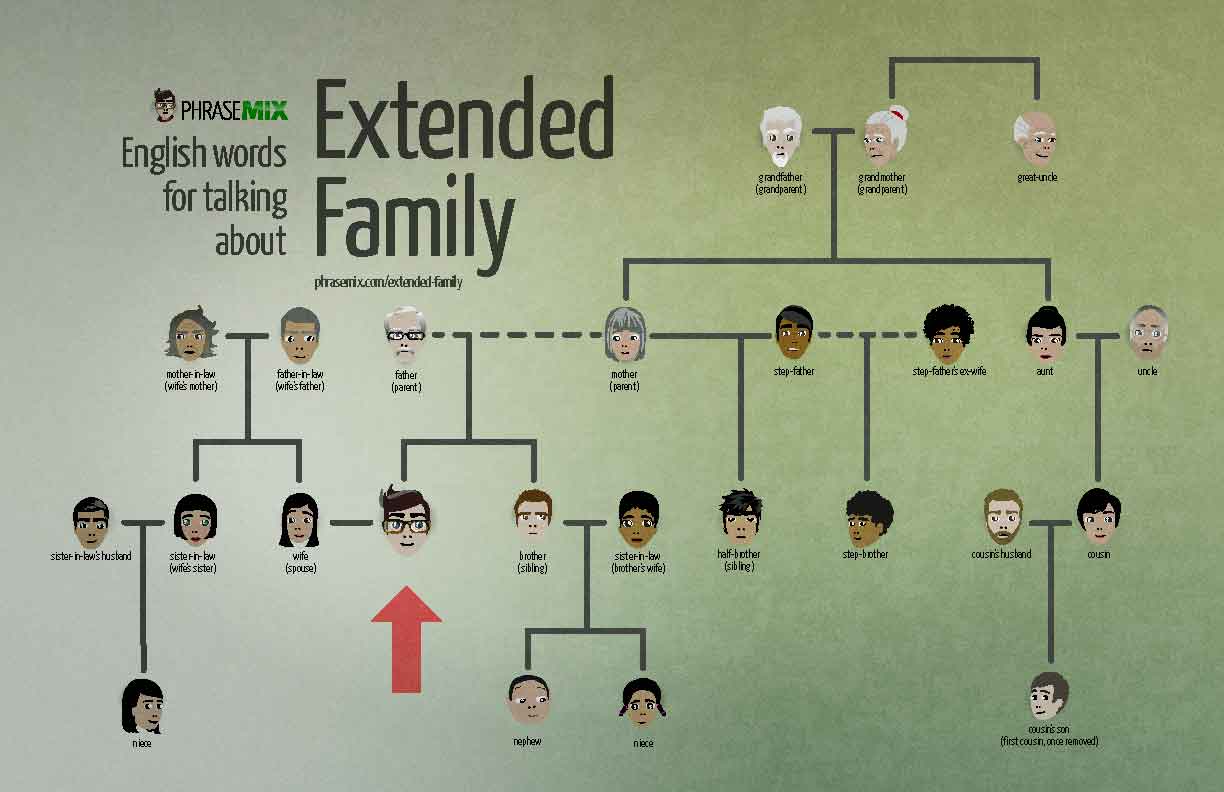33 English words and phrases for talking about your extended family
You probably already know how to talk about your immediate family in English. Your immediate family includes your mother, father, sister, sisters, brothers, husband, wife, and children.
But you might have some questions when it comes to your extended family and some complicated family relations. Let's look at how to describe those people.
Grandparents and great-grandparents
As you know, your parents' parents are your "grandparents". English speakers use lots of different names for grandparents, but when they talk about them to other people, they usually just use the words "grandfather" and "grandmother":
Hey, Nana. How are you?
I went to see my grandmother this weekend.
You can specify which grandparents you mean by saying whose "side" they are on:
My grandmother on my mom's side is Korean.
Or you can call a grandparent on your mother's side your maternal grandparent. A grandparent on your father's side is a paternal grandparent. These are more formal:
The patient says that his maternal grandfather died of brain cancer.
Your grandparents' parents are your great-grandparents. You might also have great-uncles and great-aunts. These are your parents' aunts and uncles.
You can keep adding "great-" for each generation:
My great-great-great-grandfather fought in the Civil War.
People like your great-grandparents and great-great-grandparents can also be called your ancestors:
My ancestors came here from France at the beginning of the 18th Century.
In the other direction, you may have grandchildren, great-grandchildren, and so on. These are your descendants.
Other Extended Family
Your grandparents are part of your extended family. Other extended family members include your aunts and uncles. In English we usually call someone "aunt" and "uncle" whether they are related by blood or by marriage:
We're going over to Uncle Brian and Aunt Polly's house on Sunday.
In some families, kids also call their parents' close friends "Aunt" or "Uncle".
Your cousins are other people who you're related to. When people talk about "cousins", they usually mean first cousins. A first cousin is the child of your parents' brothers or sisters.
We also count other distant relatives as cousins. A second cousin is one of your parents' cousins' children. and a third cousin is one of your grandparents' cousins' children. You can even talk about a "second cousin once removed", which is a complicated relationship that many English speakers have heard of, but only a few of us understand. You can read a full explanation on Wikipedia.
Your brothers and sisters are also called your siblings. The son of one of your siblings is your nephew, and the daughter of one of your siblings is your niece.
In-Laws
Your husband or wife's family are your in-laws. You call members of your spouse's family "mother-in-law", "brother-in-law", and so on. But that usually stops with immediate family. For extended family, you need to explain the relationship more clearly:
My wife's grandmother passed away last week.
You can also call your child's wife or husband your "daughter-in-law" or "son-in-law":
My daughter and son-in-law are in town this week.
More Complicated Family Relations
Divorces, remarriages, and adoptions create other kinds of relationships.
A step-mother or step-father is someone who's married to your father or mother.
If your step-mother or step-father has children from a previous relationship, those are your step-brothers or step-sisters. But if your parent and step-parent have a child together, that's your half-brother or half-sister.
People who were adopted have a few other kinds of family members. They usually calls the people who adopted them "mother" and "father". These are their adoptive parents.
They call the mother and father who created them their "biological parents" or "birth parents".
Try it out!
Think through all of the people in your extended family and try to explain how they're related to you in English.
Download the graphic
The illustration at the top of this lesson shows some of the family relationships that we discussed. Download it as a PDF to learn more.
Print this List





